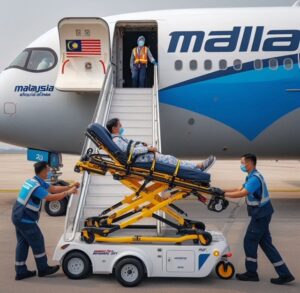
An ambulift evacuating a sick passenger (an AI illustration only)
What do pilots do if there is a medical emergency onboard?
In the event of a medical emergency onboard, the captain’s primary concern is to ensure the safety and well-being of the affected passenger while maintaining overall flight safety. Typically, the cabin crew informs the captain about the situation, and the captain coordinates with them to ensure that the airline’s medical emergency protocols are followed. This includes using the onboard medical kit and automated external defibrillator (AED) if needed for cardiac issues.
An announcement is usually made to ask if any medical professionals onboard can assist. Simultaneously, the captain contacts ground-based medical support for advice on managing the emergency. Some airlines, like Emirates, partner with MedAire’s MediLink services—a real-time medical support system that assists flight crews during in-flight emergencies.
Through a satellite link, MediLink connects the crew to doctors and specialists who help assess and manage the situation. This assistance is crucial in determining whether an emergency landing is necessary or if the issue can be managed onboard until the flight reaches its destination.
Such services are invaluable, providing expert medical guidance when immediate attention is required, especially in the absence of medical professionals onboard. For the captain, this support alleviates the difficult decision of whether to divert the flight when lacking sufficient specialist medical information to make an informed choice.
For airlines without MediLink or similar services, the decision to divert falls entirely on the captain. There is no strict policy dictating when a flight should be diverted; the decision involves evaluating multiple factors, such as the condition of the ill passenger, whether the nearest airport has adequate medical resources, and whether a diversion would require dumping fuel.
There have been unfortunate cases where captains continued the flight, prioritizing economic or operational factors over the patient’s health, sometimes with dire consequences.
Thankfully, a recent example occurred on July 20, 2024, when the captain of a Malaysia Airlines flight from London to Kuala Lumpur requested an emergency landing at Heydar Aliyev International Airport in Azerbaijan due to a passenger suffering a heart attack. The Airbus A350 successfully landed in Baku, and a specialized vehicle known as an “ambulift” was used to evacuate the passenger.
Flight crews are trained to handle medical emergencies effectively, but when a passenger’s condition becomes critical, the captain has the authority to divert the aircraft to the nearest suitable airport to ensure they receive timely medical attention. Ultimately, the goal is to balance passenger safety and the broader implications of a diversion.
Read ‘Malaysian flight makes emergency landing in Baku’ in Azernews here